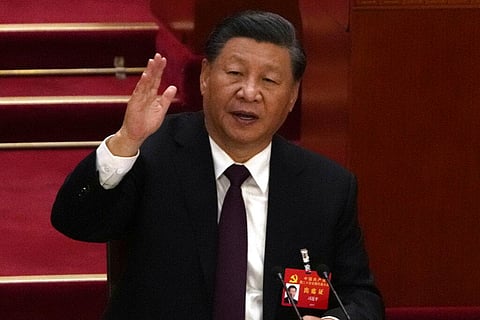

It could be a metaphor befitting our times. Two construction workers in China, looking for a way out, ploughed a hole through the Great Wall. It was not an option available to G20 Sherpas skirting past punctuation of interests and faultlines. Crafting consensus on crucial global issues -- already challenged by vertical and horizontal divergences -- is daunted by China’s new wall of geopolitical ambitions.
Consider the struggle to articulate an approach on the war in Ukraine. The Leaders Declaration at Bali in 2022 accepted that the G20 is not a forum for security issues depending on Prime Minister Narendra Modi’s observation that this is not the era for war. In Delhi too, China strenuously opposed the inclusion of geopolitical issues in the declaration. The fact is geopolitical action has geoeconomic consequences.
The timing of events illuminates the shadow of intent. Just a week before the Delhi Summit China chose to unveil a map appropriating territories of India, Indonesia, the Philippines, Malaysia, Nepal, and Taiwan. The West has long suspected that Russia was helped with arms by China, Iran and North Korea. On September 10, Russian President Vladimir Putin is expected to travel to the port city of Vladivostok to meet North Korean leader Kim Jong Un. On the agenda: talks on weapons supplies. Also invited to the meeting is Zhang Guoqing, former vice premier and politburo member.
The impact of evolving fault-lines in the world order is manifest. The emerging consensus at the Delhi G20 is that a “cascading crises” poses challenges to long-term economic growth. This, of course, is not exactly an Eureka moment! The IMF, in its April report, forecast global growth to be around 3 per cent for five years – the lowest since 1990. The United Nations in July 2022 warned of a cascading crisis threatening human survival.
The state of the world economy is visible in the data pouring out of nations. The world’s biggest economies are struggling. Germany, the United Kingdom and much of Europe is yo-yoing between stagflation and recession. GDP growth in China is at its lowest since 2012 when Xi Jinping took charge. The debate now is not when but if China will overtake the US. The jury is yet out on when the United States will enter recession. India’s economy, now the fifth largest, has performed exceptionally but could be afflicted by global slowdown.
The cause lies in a sequence of events – the pandemic followed by the war in Ukraine – and the consequences thereof. The measures to contain inflation drove up the cost of capital, slowed growth and now present risks for financial stability. Geopolitics triggered de-risking and deglobalisation. This accelerated existing disruptions –ageing demographics, induction of technology and climate change. In 2008 the G20 came together to scaffold the global economy. In 2023, the G20 is confronted with a world drifting apart.
On the face of it, Xi Jinping has waxed eloquent on free trade. On September 2, speaking at a trade meet he observed that “the world economy thrives in openness and withers in seclusion”. On the ground, this week China ordered a ban on the use of Apple’s iphone across government, enterprises and agencies. It comes close on the heels of the launch of Huawei’s Mate 60 Pro with 7-nanometer SMIC processor and a week before Apple’s launch of its new editions on September 15. This is not the first ban. In 2022, China banned use of all foreign PCs in government offices, opening up the market for Chinese PCs and in 2021 banned Tesla cars from government compounds.
There is protectionism and then there is obstructionism. India has passionately espoused the cause of Global South under the theme of ‘One Earth, One Family, One Future’. The admission of the African Union into the G20 effectively makes it G21 as it ushers in representation. The report of the committee led by N K Singh and Lawrence Summers finalised the draft blueprint for reforming multilateral agencies to fund development. But success depends on how effectively G20 nations campaign to enable relief for the indebted.
READ MORE | One Nation, One Election, One Opposition
There are 70 low income countries listed by the IMF as distressed. Bonds of 21 countries worth $ 240 billion are trading at distress prices. The G20 ‘Common Framework’ is flailing. There is the circumstance of rising interest rates and the China factor. China has lent around $ 1 trillion to over 150 countries – of which $ 82 billion is to poor countries described as the debt diplomacy trap. Restructuring depends on cooperation of lenders. The big roadblock to resolution, as US Treasury Secretary Janet Yellen termed it, is China.
For a decade, under Xi Jinping, China has tried to propel subscription for its idea of a new world order. The expansionist agenda – be it the annexation of Taiwan or the repeated incursions into India – is scarcely disguised by its formulation of a new world order as different from the post-colonial
post-war template.
The world faces a confluence of existential crises and survival rests on interdependence. This column observed earlier that the powerful are also dependent. The Delhi Declaration was made possible by the network of emerging economies. The G20 cannot stop with articulating an agenda. Success calls for mastering the art of leveraging dependence to vault over the wall of geopolitics and operationalise the agenda.
Shankkar Aiyar
Author of The Gated Republic, Aadhaar: A Biometric History of India’s 12 Digit Revolution, and Accidental India
(shankkar.aiyar@gmail.com)